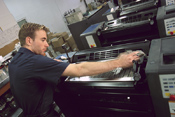
|
|
What is Quality Assurance?

Quality assurance, or QA for short, refers to planned and systematic production processes that will provide confidence in a product's suitability for its intended purpose. It is also a set of activities that is intended to ensure that products (goods and/or services) satisfy customer requirements in a systematic, reliable fashion. It is important to understand that QA cannot absolutely guarantee the production of quality products, but makes this more likely.
|
|
There are two key principles that characterize QA.There are:
- "Fit for purpose" (the product should be suitable for the intended purpose)
- "Right first time" (mistakes should be eliminated).
It is important to realize that quality is determined by the intended users, clients or customers, not by society in general.It is not the same as 'expensive' or 'high quality'. Even goods with low prices can be considered quality items if they do meet a market need.
From the earliest days of manufacturing there have been attempts at QA. When the first specialized craftsmen started manufacturing tools and materials for others to purchase and use, the principle of quality was simple: "Let the buyer beware!" (Caveat emptor).
A look through history can easily spot attempts at QA. Early civil engineering projects needed to be built from specifications, for example the four sides of the base of the Great Pyramid of Giza were required to be perpendicular to within 3.5 arc seconds. During the Middle Ages, guilds adopted responsibility for quality control of their members by setting and maintaining certain standards for guild membership. Royal governments who were purchasing material were interested in quality control as customers. For this reason, King John of England appointed William Wrotham to report about the construction and repair of ships. Centuries later, Samuel Pepys, Secretary to the British Admiralty, appointed multiple overseers of QA.
Prior to the extensive division of labor and mechanization that resulted from the Industrial Revolution, it was possible for workers to control the quality of their own products. Working conditions then were arguably more highly conducive to professional pride. The Industrial Revolution led to a system in which large groups of people performing a similar type of work were then grouped together under the supervision of a foreman who was appointed to control the quality of work that was manufactured. This was the earliest post-Industrial Revolution attempt at QA.
It is important to understand that differences between quality assurance versus quality control.
Where quality control emphasizes testing and blocking the release of defective products, quality assurance is about improving and stabilizing production and associated processes to avoid or at least minimize the issues that led to the defects in the first place. However it is important to keep in mind that QA does not necessarily eliminate the need for QC: some product parameters are so critical that testing is still necessary just in case QA fails.
Although there were many individuals trying to lead United States industries towards a more comprehensive approach to quality, the U.S. continued to apply the Quality Control concepts of inspection and sampling to remove defective product from production lines, essentially ignoring advances in QA for decades. This has led to a reversal back to QA practices.
Another facet of QA and a valuable process to perform on a whole consumer product is failure testing (also known as stress testing). This is the operation of a product until it fails, often under stresses such as increasing vibration, temperature and humidity. This can expose many unanticipated weaknesses in a product, and the data is used to drive engineering and manufacturing process improvements. Often quite simple changes can dramatically improve product service and improving overall QA..
Privacy Policy, Terms of Use